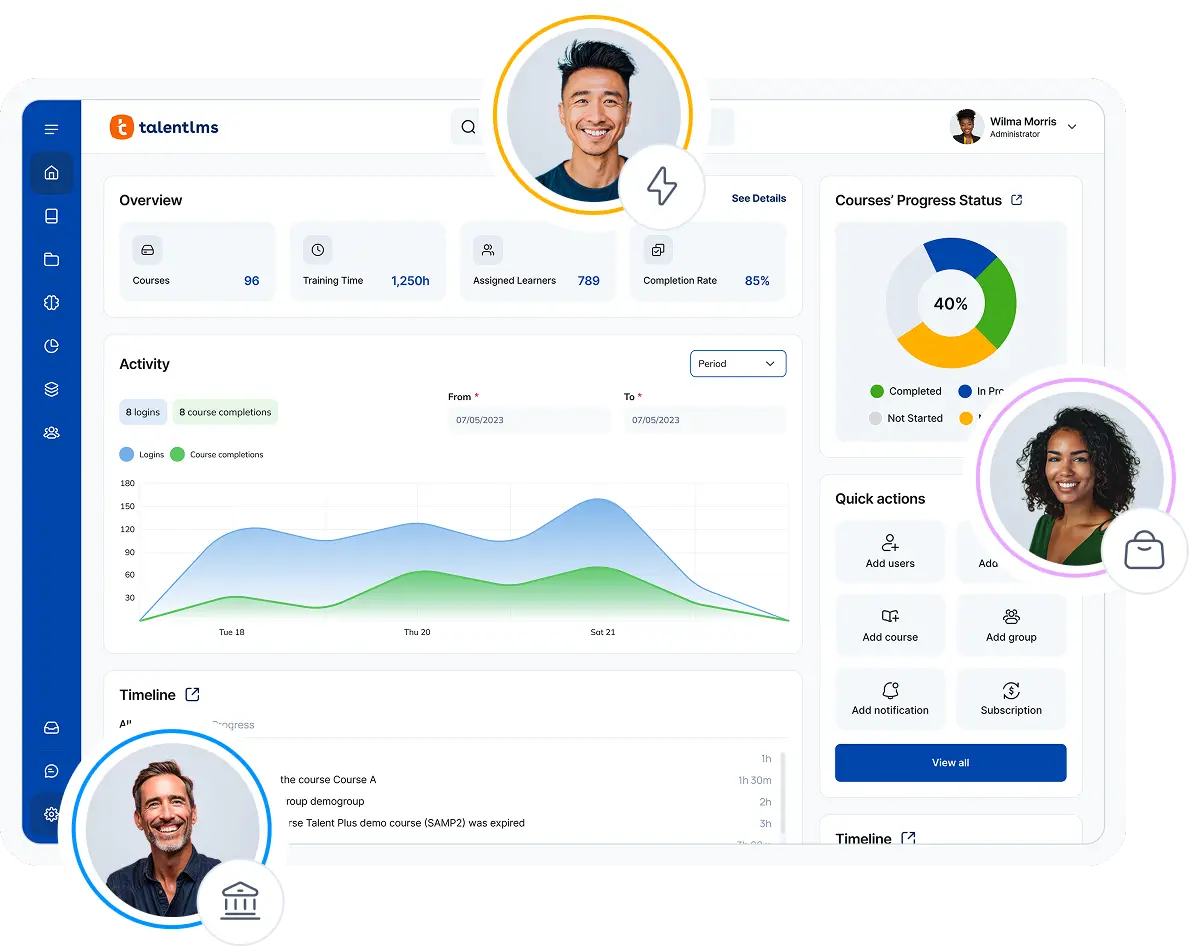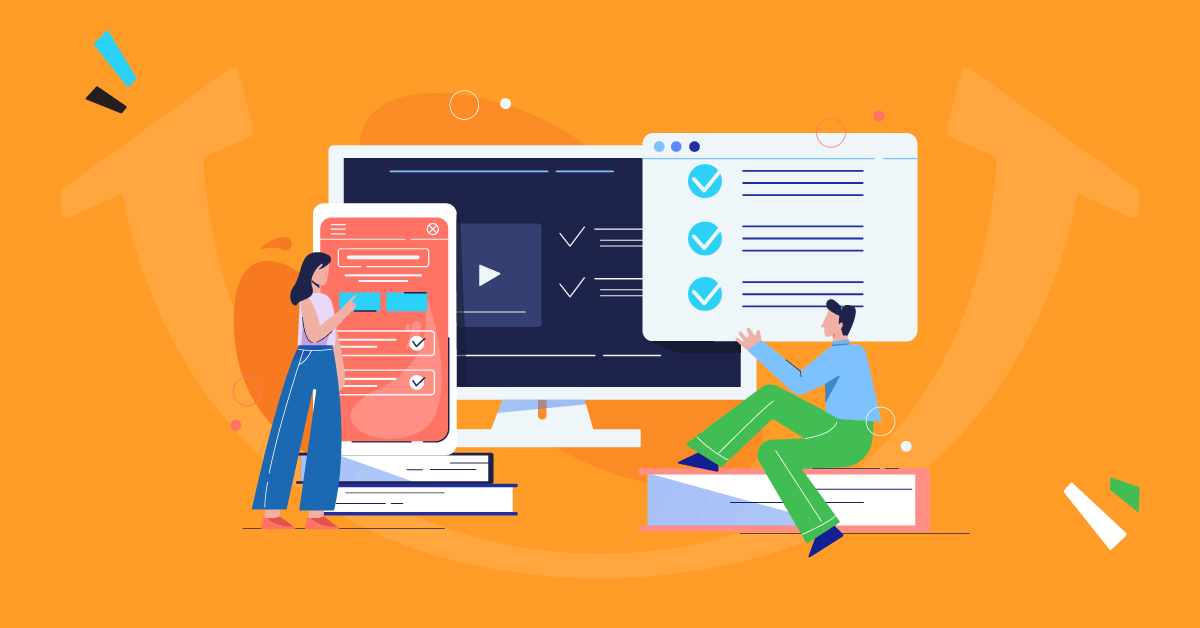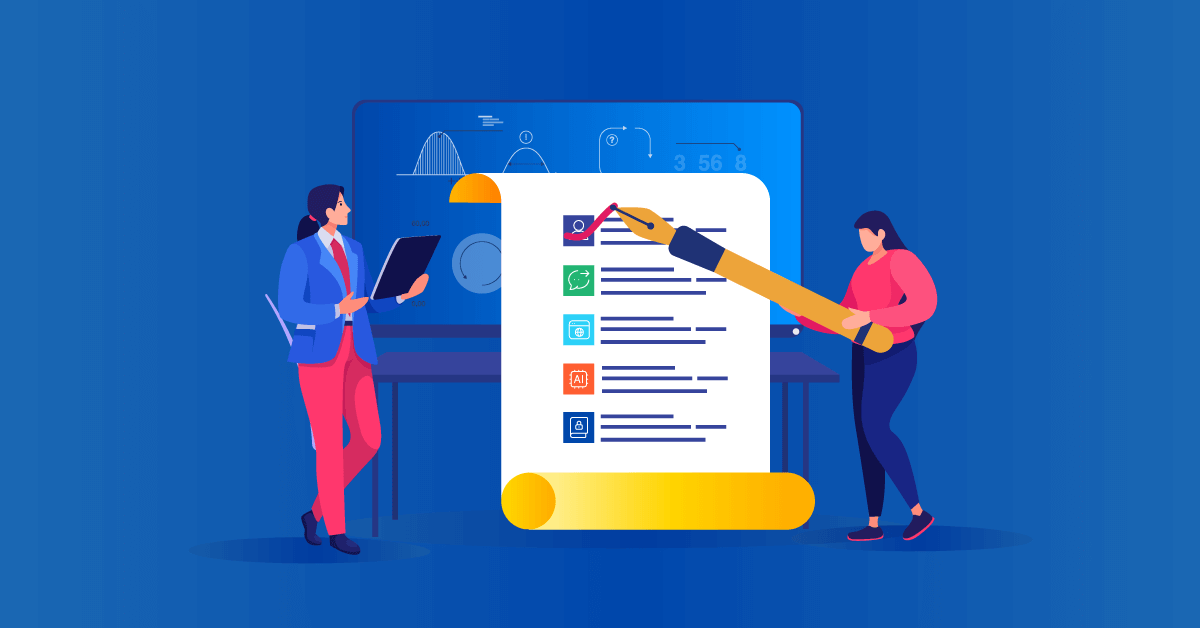- What is transformative learning theory?
- The benefits of the transformative learning theory in employee L&D
- Transformative learning theory in practice: Key principles
- Examples of transformative learning in the workplace
- How a learning management system (LMS) can support transformative learning
- Creating a supportive environment for transformative learning
Ongoing development is vital for building a happy and productive workforce. But for adult learners, learning involves more than just tacking new skills onto the old.
Your employees need to adjust their understanding of their roles and the world to make room for the skills and ideas that will help them well into the future.
Transformative learning is a top strategy for giving adult learners context. And to help them transfer learning objectives to their work.
It also allows L&D professionals to teach content more effectively and better support teams in their learning journeys.
Let’s dive into what transformative learning theory is and how you can apply it to your own eLearning course development.
What is transformative learning theory?
Transformative learning, also called transformational learning theory, is a theory focused on how learners adjust their understanding as they receive and process new information.
Adult education theorist Jack Mezirow developed the theory in his exploration of adult learning. The theory goes beyond simply acquiring knowledge or new skills. It explains how adults shift their understanding of the world by questioning existing beliefs and assumptions.
According to Mezirow, the transformative process of learning occurs when our existing frames of reference are challenged. Our frames of reference are the lenses through which we interpret our experiences. They include our assumptions, beliefs, values, and past experiences.
This challenge can come from a variety of experiences, such as:
- Disorienting dilemmas. Unexpected events or situations force people to question their long-held beliefs.
- New information or perspectives. People encounter information or viewpoints that contradict current understanding.
- Critical reflection. Personal assumptions and biases are assessed objectively from a distance.
The 10 phases of transformational learning: a journey of self-discovery
Mezirow’s transformative theory doesn’t just describe the ‘what’ of transformative learning. It also describes the ‘how’. It outlines a ten-phase process learners travel as they reconstruct their frames of reference.
The order and duration of the transformative learning phases vary for each individual. But they provide a roadmap for the journey of questioning, reflecting, and transforming mindsets.
Here are the phases and what happens in each:
- A disorienting dilemma. Transformation often starts with a disruptive experience that challenges existing beliefs. This could be a personal setback, a new job role, or encountering a conflicting viewpoint.
- Self-examination with feelings of alienation. The disorienting dilemma can lead to confusion and a sense of alienation as learners recognize the inadequacy of their current understanding. They begin to look inward and question assumptions.
- Critical assessment of assumptions. Learners identify and critically analyze the underlying assumptions that shaped their previous viewpoints. This might involve examining cultural background, life experiences, or biases.
- Recognition. Learners re-examine past experiences through the lens of their new awareness. This helps them identify how assumptions may have colored their interpretations.
- Exploration of new roles or perspectives. Learners begin to explore alternative viewpoints. This might involve seeking out new information, engaging in discussions, or experiencing different cultures.
- Planning a course of action. Learners start formulating a plan for integrating what they’ve learned into their lives. They may set goals, change behaviors, or pursue new opportunities.
- Acquisition of knowledge and skills. Learners may need new knowledge or skills to implement their action plan. This could involve taking courses, seeking mentorship, or enrolling in training programs.
- Provisionally trying out new roles. Learners begin to experiment with new behaviors and ways of thinking. This might include taking on new responsibilities. It might mean trying out different approaches to problems. Or it may mean engaging with others in new ways.
- Building competence and self-confidence. As learners gain experience with new ideas and behaviors, their capability grows. This boosts self-belief, which reinforces their commitment to the transformation.
- Reintegration into life with a new perspective. Newfound understanding shapes learners’ interactions. It impacts how they engage with the world, their relationships, and their sense of self.
While the model provides a framework, transformative learning is not always a linear process. It can be messy, emotional, and take time. However, the benefits of this type of journey outweigh any concerns.
The benefits of the transformative learning theory in employee L&D
Traditional employee learning and development programs often focus on skill acquisition and knowledge transfer.
While these are important, transformative learning theory offers a deeper approach. It promises far-reaching benefits for both employees and organizations. These include:
Enhanced self-awareness
Transformational learning encourages critical reflection, helping employees question their assumptions and biases. They get a greater understanding of their own motivations, strengths, and weaknesses.
This self-awareness empowers them to make better decisions, manage emotions, and build stronger relationships.
Adaptability and innovation
Mezirow’s transformative learning theory encourages employees to embrace new ideas and perspectives. When they’re open to change, they’re more prepared to handle unexpected obstacles and adapt to changes at work.
They’ll have the flexibility to navigate challenges. And the openness to innovate solutions to complex problems.
Critical thinking and problem-solving
A transformative learning experience hones critical thinking skills. Employees learn to analyze situations from many angles, consider alternative solutions, and make well-reasoned decisions.
The ability to think critically can lead to more effective problem-solving. It can also improve decision-making and lead to a more strategic approach to work.
Motivation and engagement
Employees who experience transformative learning often feel more engaged and motivated. Both lead to increased productivity, higher morale, and a more positive workplace.
When people are engaged and happy at work, they’re more likely to perform better. And to stay with your company longer, saving you the costs and frustrations of employee turnover.
Leadership development
Transformational learning nurtures key skills associated with impactful leadership. For example, resilience, decision-making, agility, and insight.
Through transformative learning, you can prepare employees for future leadership roles. You’ll develop a pool of internal talent that will keep your company thriving down the road.
Transformative learning theory in practice: Key principles
A few key principles create the foundation for transformative learning theory. These include:
- Disruption as a catalyst. Transformative learning theory sees challenges as the spark that ignites transformation. Uncomfortable situations often lead to deeper reflection and reevaluation.
- The power of reflection. Examining assumptions, biases, and beliefs is essential for overcoming outdated attitudes. And for paving the way for new understanding.
- Learning through dialogue. Transformative learning is not a solitary pursuit. Engaging in open and honest dialogue with people who have different viewpoints helps learners challenge their own thinking.
- Reconnecting with experience. Re-examining past life experiences through the lens of new critical awareness reveals how assumptions influenced ideas and decisions.
- Integration into life. The ultimate goal of transformational learning theory is not just intellectual understanding but practical application. Learners must integrate what they learn into their daily lives to change behaviors.
By embracing these core principles, you can create a transformative learning experience that goes beyond simply imparting knowledge. You can promote critical thinking, self-reflection, and open dialogue.
Examples of transformative learning in the workplace
There are lots of ways to include transformative learning theory principles in a business environment. Doing so will encourage employees to start transformative journeys toward professional and personal growth.
Here are a few transformative learning examples:
Cross-functional challenge
Give learners opportunities to work with others outside their own team. Collaborating with another department gives them a chance to see another side of the work they do. It will expand their understanding of the job and others’ experiences.
Example
Imagine an engineering team that’s used to siloed work. They’re asked to collaborate with marketing to develop a user-friendly product manual. This cross-functional project helps the engineers see their work through the lens of the customer. They build empathy and a better understanding of the product development process.
Scenario-based learning
Scenario-based learning is a powerful tool for applying transformative learning theory. It lets learners experience a new or challenging situation in a safe environment.
Practicing unfamiliar skills and behaviors in advance can help develop “muscle memory,” making the skills easier to use on the job.
Example
Have the team role-play ethical decision-making in a training session. For example, introduce the situation of a sales manager pressuring them to close a deal, even though they suspect the client may be misrepresenting their needs.
Learners can discuss alternative approaches, communication strategies, and company policies in the session. And then put into practice ways to handle this uncomfortable situation. This approach also creates a culture of open communication. The result? Learners will feel more comfortable discussing these kinds of concerns at work in the future.
Diversity, equity, and inclusion (DEI) training
Diversity, equity, and inclusion training ensures everyone feels valued and respected. It’s focused on opening learners’ eyes to assumptions and biases that can lead to excluding others.
The training helps learners see their own behaviors and assumptions in a new light. And then learn how to intentionally create a safe, inclusive environment at work.
Example
A team participates in training on recognizing and eliminating unconscious bias in the workplace. This may be an online module or a workshop where they learn the concepts and then discuss what these might look like in their company.
TalentLibrary – Skills that matter, courses that deliver
With TalentLibrary, you set the foundation for a strong, aligned workforce—soft skills, compliance, and workplace essentials, from day one (and beyond).
People begin to understand how their limited experiences and viewpoints affect underlying beliefs. This starts the process of introspection. As they learn from one another, they’re able to start to see things differently.
This practice creates new awareness. It also builds an understanding that the company lives its values and expects employees to do the same.
How a learning management system (LMS) can support transformative learning
A well-designed Learning Management System (LMS) can enhance the transformative learning process. Here’s how to use employee training software to support your training strategy:
Curated learning resources
An LMS allows you to create and organize diverse learning materials. For instance, you might build a library of articles, videos, podcasts, and case studies in addition to training courses.
This allows you to cater to different learning styles and spark critical reflection. Employees will be able to explore a variety of perspectives on a topic. As they consider other viewpoints, they’ll start to challenge their existing assumptions.
Discussion forums and collaboration tools
Discussion forums and collaborative tools allow learners to share their experiences, debate ideas, and learn from each other’s diverse viewpoints. This collaborative environment promotes critical thinking and the development of new perspectives.
Personalized learning paths
Modern LMS customization options let you tailor learning to individual needs. With personalized learning paths, employees can explore topics related to their current challenges and growth goals.
Feedback and progress tracking
An LMS can facilitate constructive feedback from peers or trainers. Learners will get insights into their performance and progress. They’ll also be able to track their learning progress through quizzes or assignments, giving them a sense of accomplishment.
An LMS is a tool, not a replacement for the core elements of transformative learning theory. But, when you leverage its functionalities, you can create better learner engagement. And an environment that will encourage transformative learning journeys.
Creating a supportive environment for transformative learning
Transformative learning thrives in a supportive setting. One that encourages critical reflection, open dialogue, and a willingness to challenge the status quo.
Create the right culture by making it safe for employees to share concerns, ask questions, and admit mistakes. This begins with leaders modeling and encouraging respect, trust, and open communication.
You can use some of the suggestions above for transformative learning in the workplace. Then make transformation a part of your culture by celebrating employee progress. Acknowledge personal growth, new perspectives, and willingness to embrace change.
Also, understand that transformative learning is not a one-time event. It’s an ongoing journey. To unlock employees’ full potential, you’ll need to embrace its core principles across your learning strategy. And when you do, you’ll empower employees to become not only more skilled but also more adaptable, innovative, and critically aware.
Originally published on: 24 Jun 2016





